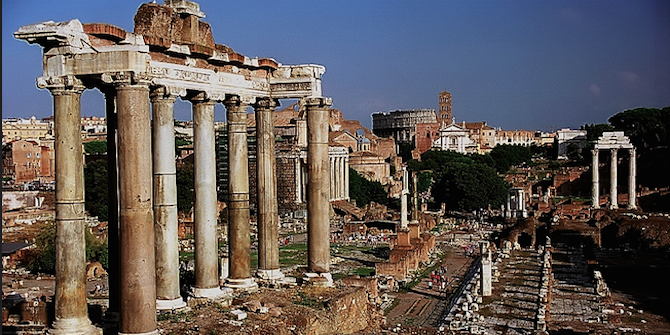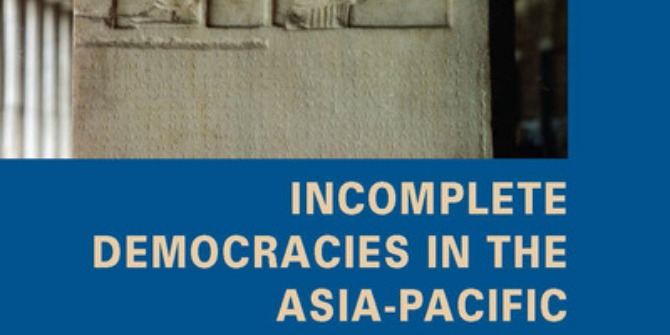Politics in the Middle East is now seen and the image is playing a central part in processes of political struggle. This book aims to engage directly with these changing ways of communicating politics in the region. Lina Khatib presents a cross-country examination of emerging trends in the use of visuals in political struggles in the Middle East, from the Cedar Revolution in Lebanon to the Green Movement in Iran, to the Arab Spring in Egypt, Syria and Libya. Olivia Mason finds it a thought-provoking read utilizing sources from numerous academic disciplines.

The Arab Spring has been a recent locus of academic and media attention. Investigating the events from a stimulating angle is Lina Khatib’s new book, Image Politics in the Middle East: The Role of the Visual in Political Struggle, in which the importance of the visual in the Middle East is explored. Khatib, Research Associate at SOAS, argues that ‘politics in the Middle East is now seen’ (p.1), and as a result a study of how this has occurred and the resulting way the world now understands Middle Eastern politics is essential.
Khatib’s book is unique in that it discusses not just images but numerous issues surrounding the visual and the way politics is seen in the Middle East. Khatib utilizes the term ‘image politics’ to indicate a wide variety of ways in which the term image can be used, understood, and be politically important. There is a strong sense of the political and how it relates to the visual throughout the book. The author argues that the visual must be seen as encompassing a wide range of components including ‘physical, electronic, non-electronic virtual and embodied spaces’ (p.7). The book is divided into two halves, with the more theoretical and ideological questions relating to the visual explored in the first half, such as political visibility and visual performances, and the more tangible aspects of the use of images in the Middle East by a wide variety of actors in a wide variety of sites encountered in the second half.
In Part I, the Cedar Revolution in Lebanon is highlighted as an example of the way the visual has become strongly related to politics. Lebanon has had a long history of using the visual as a political marker, with graffiti and markings often used to break up geographical zones. Since the assassination of Prime Minister Rafic Hariri on 14th February 2005 , the visual has been used increasingly in political spheres. Images have been used as a political rallying tool, with Hariri quickly turned into an icon by his supporters. Khatib uses this example to discuss how public action has been facilitated by the use of the visual to instigate political change.

In Chapter 3, ‘The Politics of [In]visibility in Iran’, Khatib continues to explore the ideological power of the image. The author argues that despite the Iranian Revolution it is still the state in Iran that has the upper hand in creating visibility. However, this does not mean totatalian rule and the invisibility of those who oppose the state does not necessarily mean they have no power. Khatib uses the example of Ahmadinejad’s disenfranchised image as an example of the power of propaganda; a powerful political icon becoming transformed into a negative one, his image defaced. Lasting media images of political events can often change how we remember them, reinforcing that images should not be seen in isolation from one another.
In Part II: Revolutionary Images, the reader encounters more technical and geographical detail about how images are used and shared. Images transcend boundaries and allow new forms of social action, most recently observed through the use of new social media to circulate images. Egypt is used as an example of the way images have become a tool for resistance. Bloggers and tweeters in the region published photos taken by citizens showing brutality from the state; ‘In doing so, the electronic image pushed the boundary of what could be represented in the public domain in Egypt’ (p. 129). Khatib also notes that the use of images in protest is particularly interesting, representing a form of passive activism.
In conclusion, this book contains food for thought on the importance of images, and the different ways the visual has been used in the Middle East. The author’s use of case studies from various countries in the Middle East successfully showcases the differing and similar ways that images are being used in the Middle East. Khatib also writes in a way that is accessible for both a general audience, but utilizes sources from numerous academic disciplines to appeal to academic audiences. Any criticisms relate to the structure of the book, the lack of a full conclusion, and no clear connections between the chapters. However, this is certainly a book that should be read by students and those with a keen interest in the topic, as it contains many new ideas about the visual, images, and Middle Eastern politics.
——————————————————————————————-
Olivia Mason is a postgraduate student at the University of Glasgow in the school of Geographical Sciences. Her research interests lie in gender, space, and power and feminist methodologies. Previously she has studied the role of tour guides in shaping the tourist gaze in dark tourist destinations in Bosnia. Her current research interests are in female Islamic blogging in the Middle East and how these blogs use emotional narratives to engage readers and create a new political space of active citizenship. Olivia also blogs at aprettyordinaryplace.wordpress.com. Read more reviews by Olivia.







